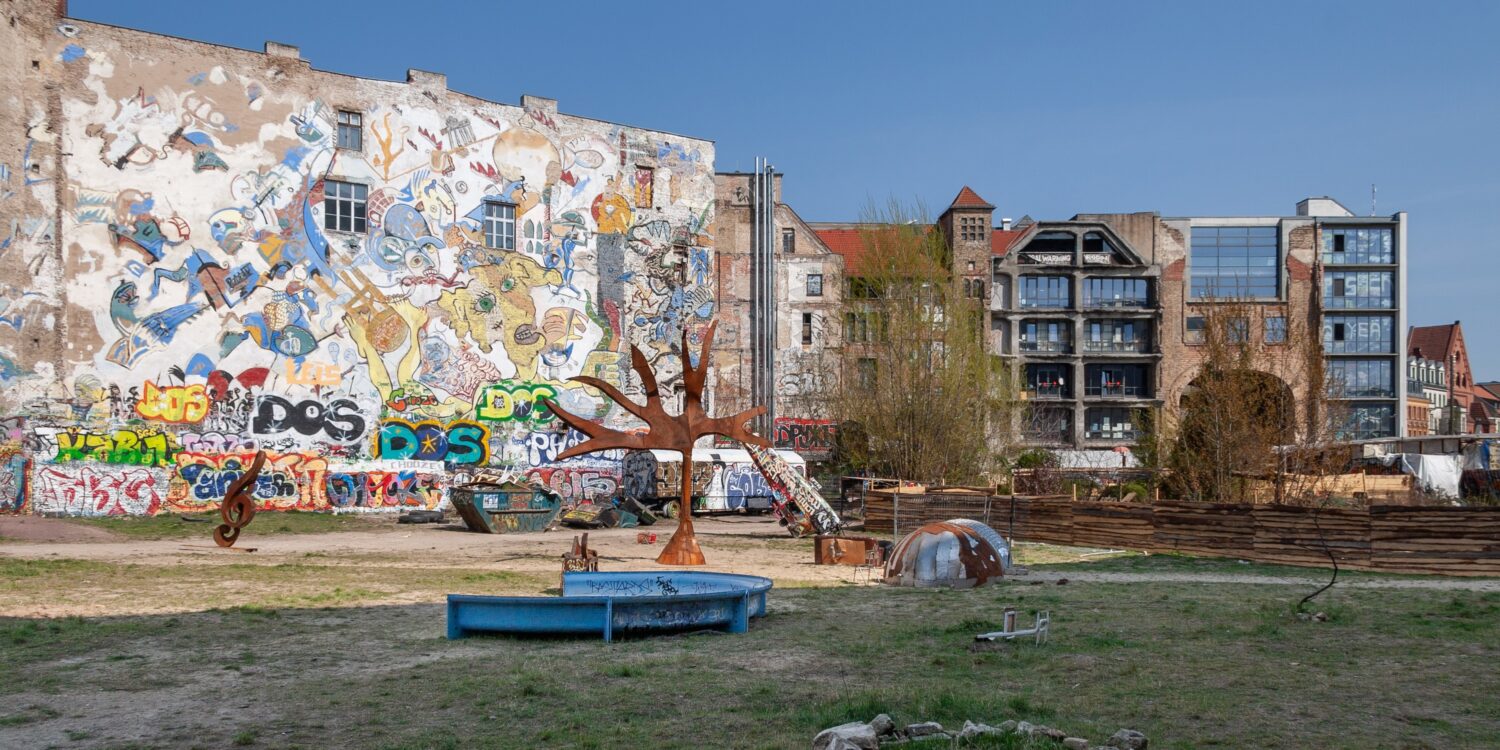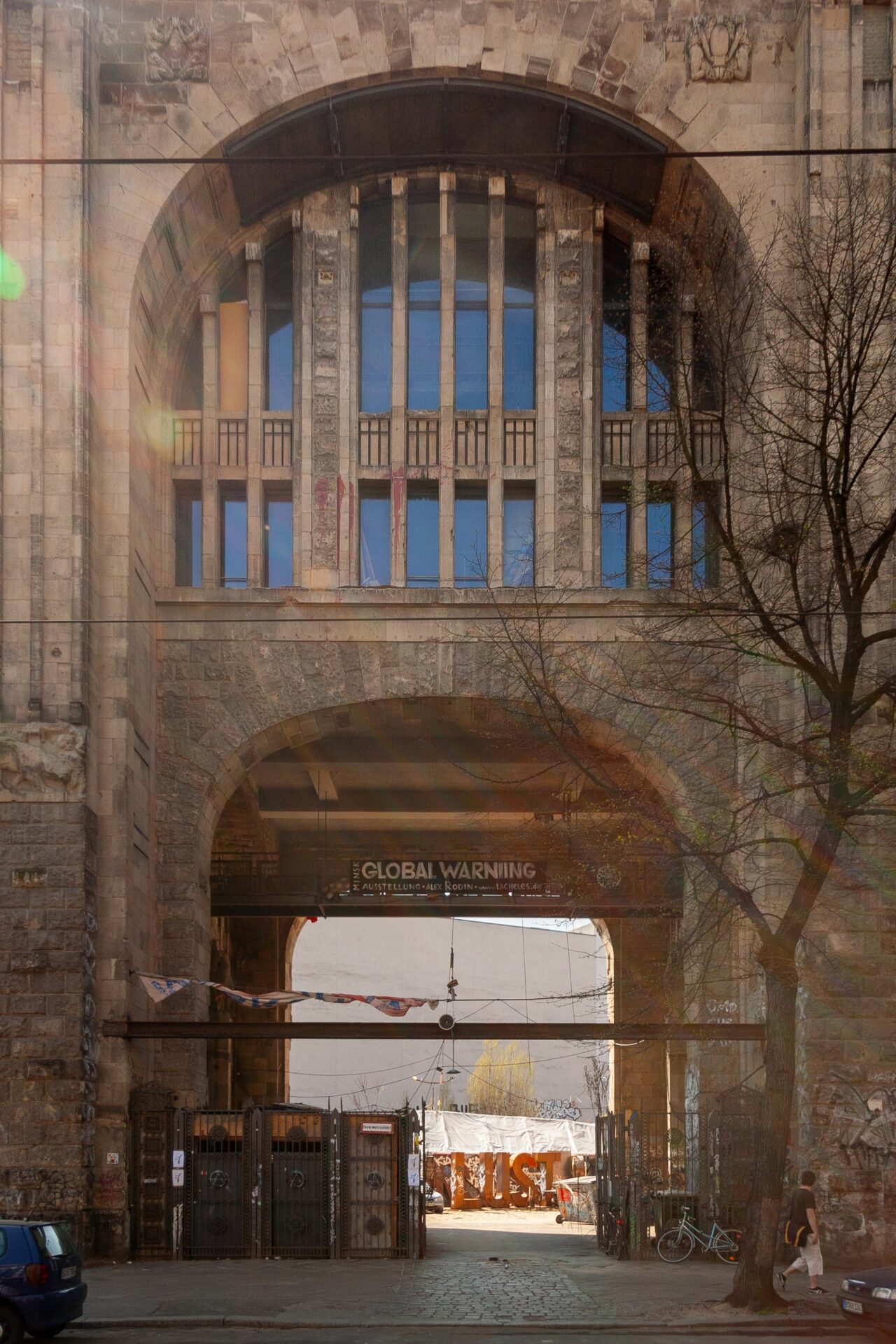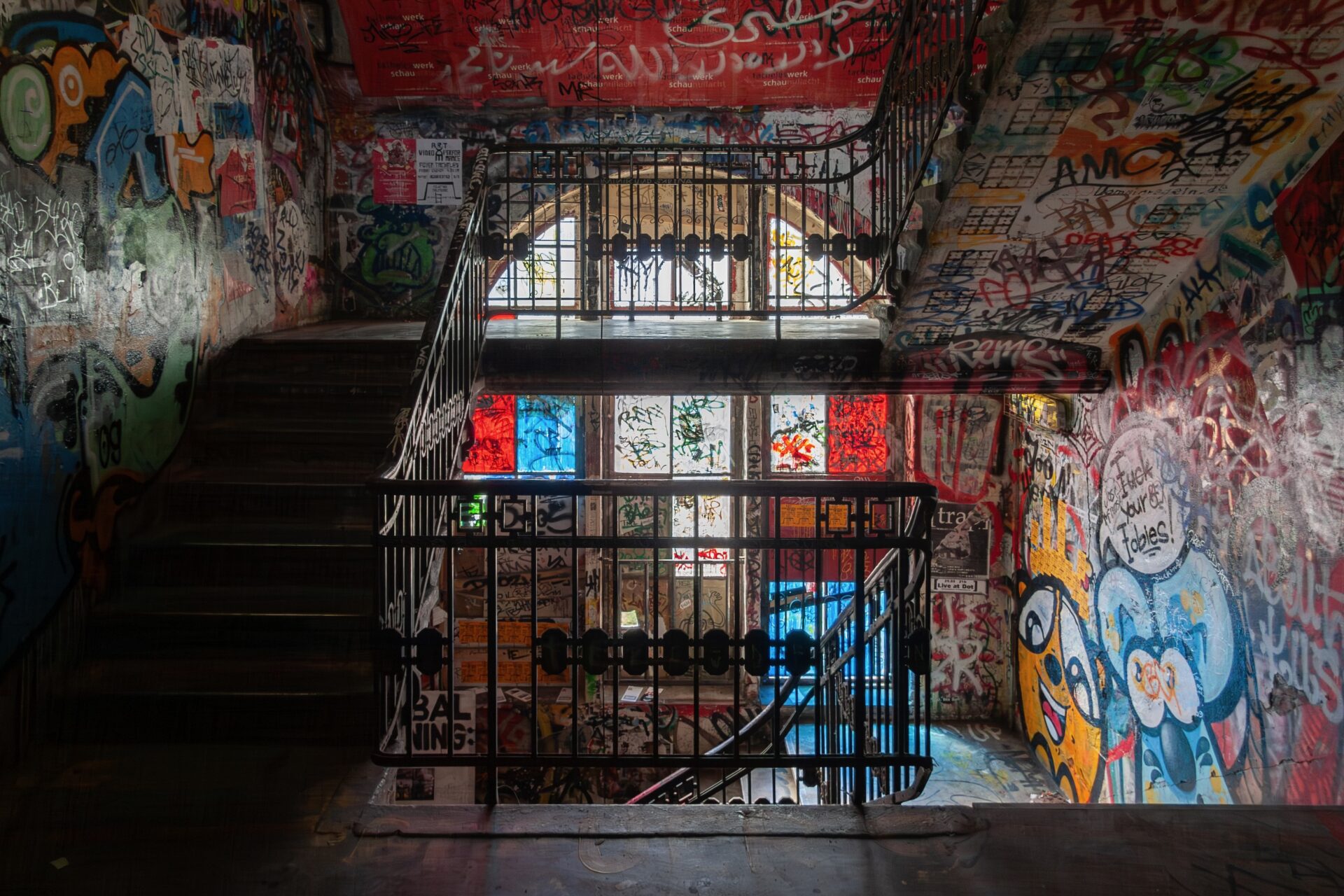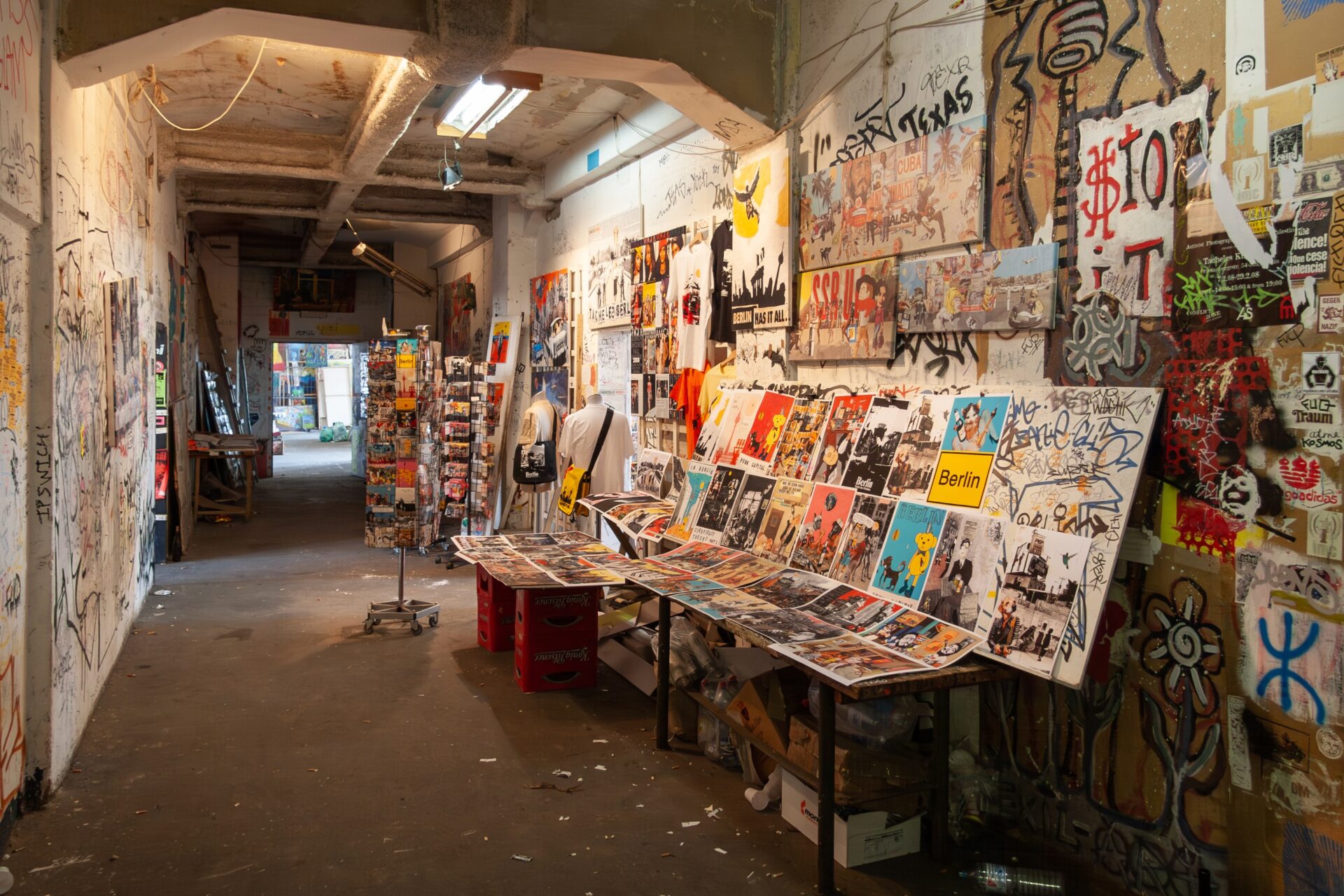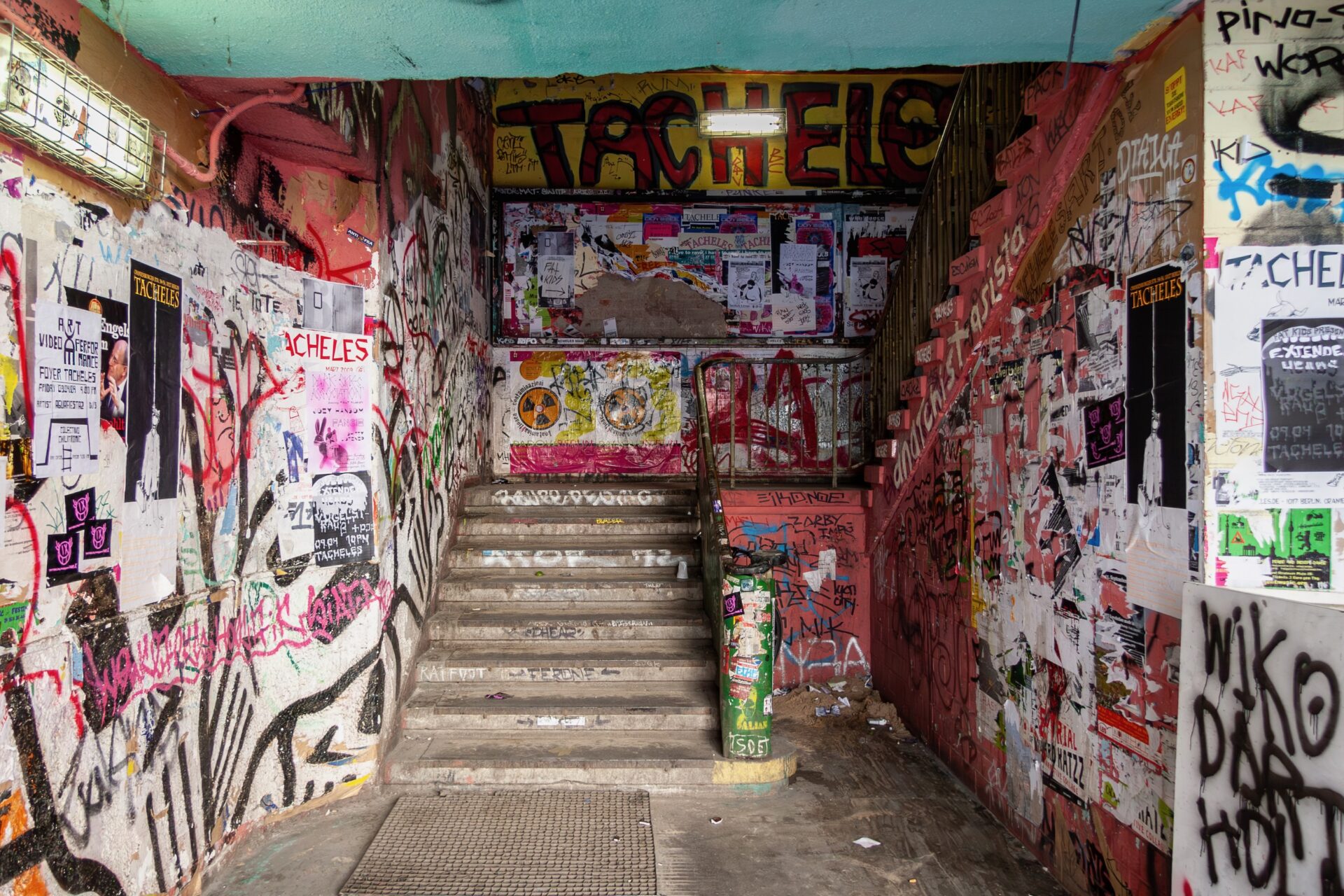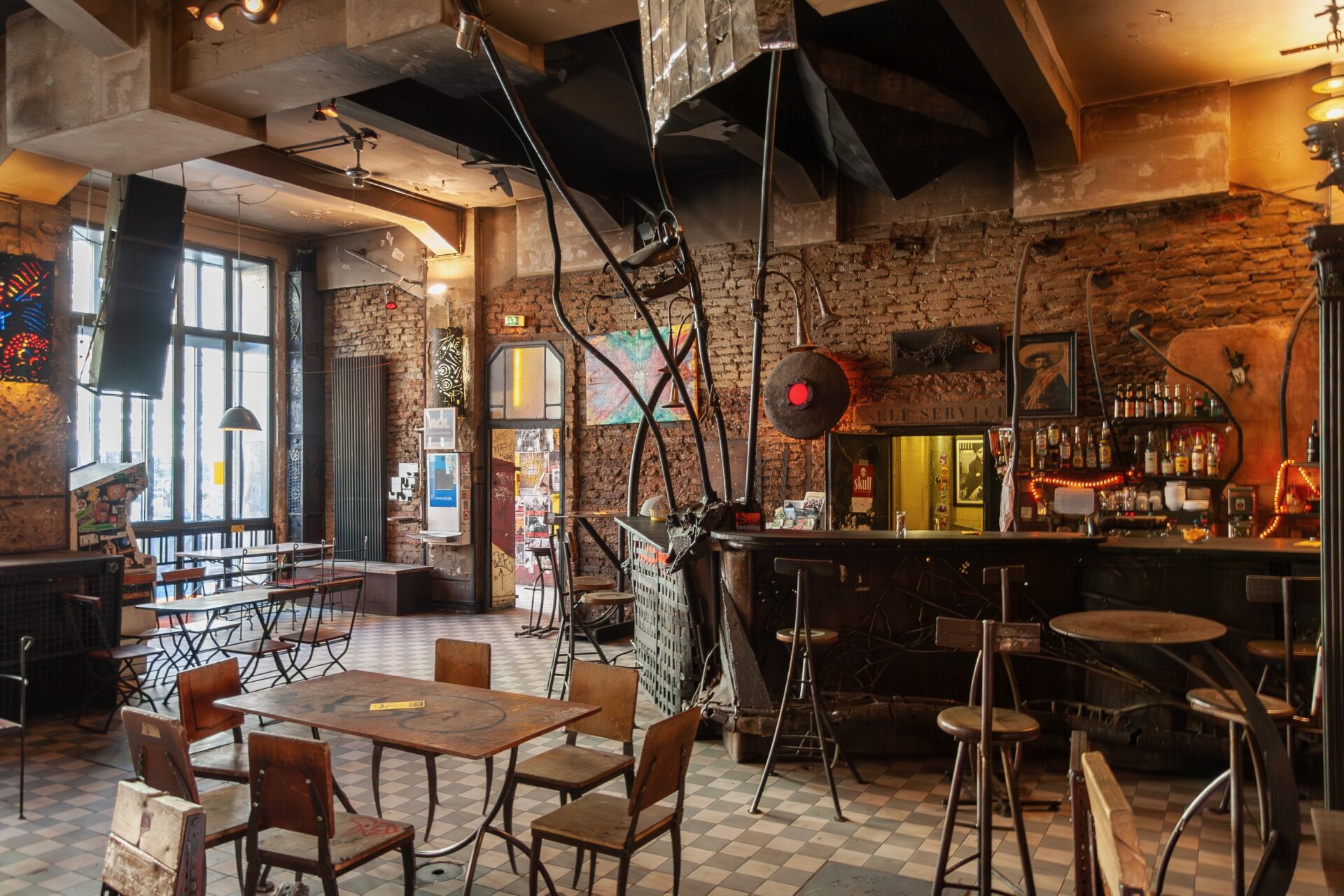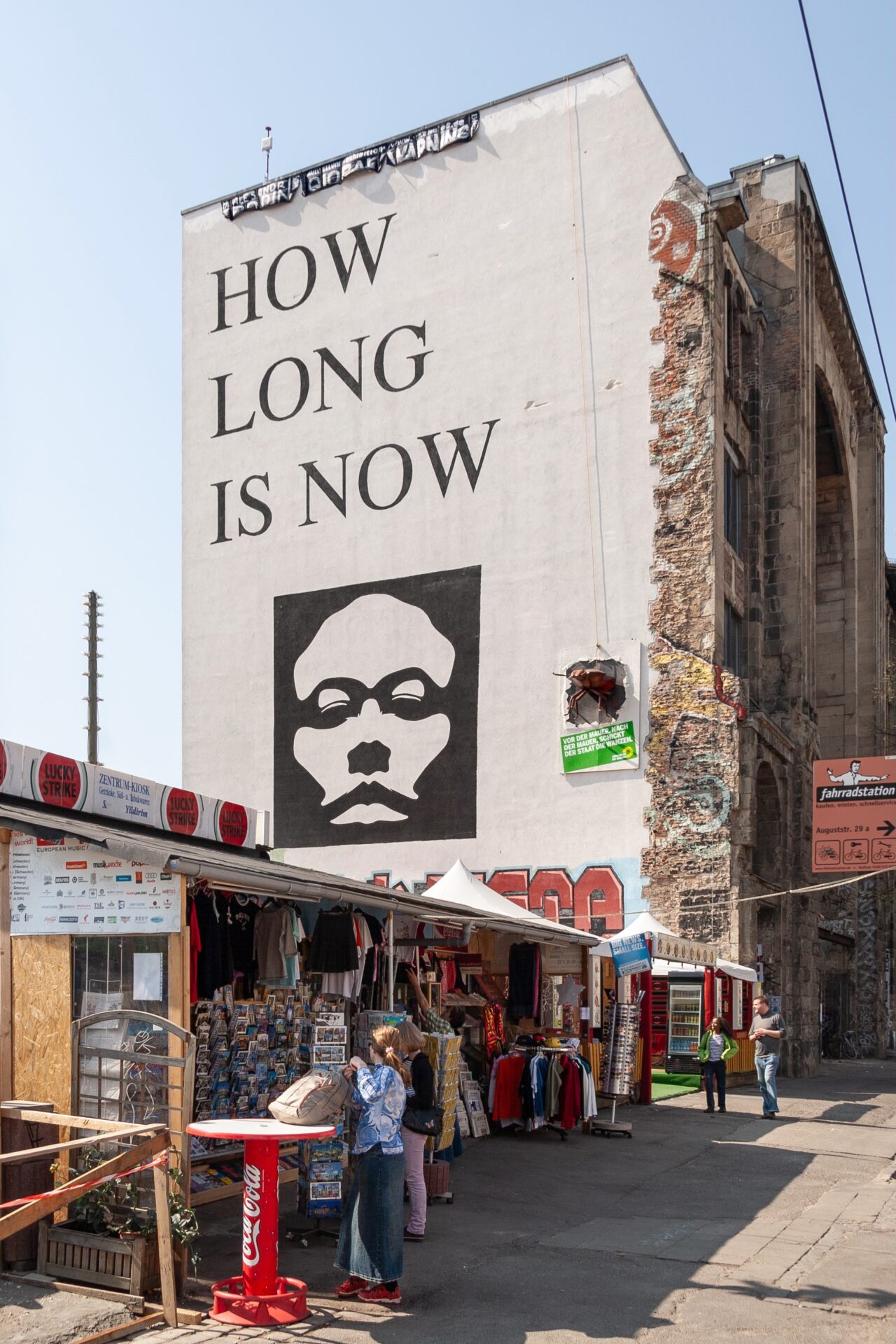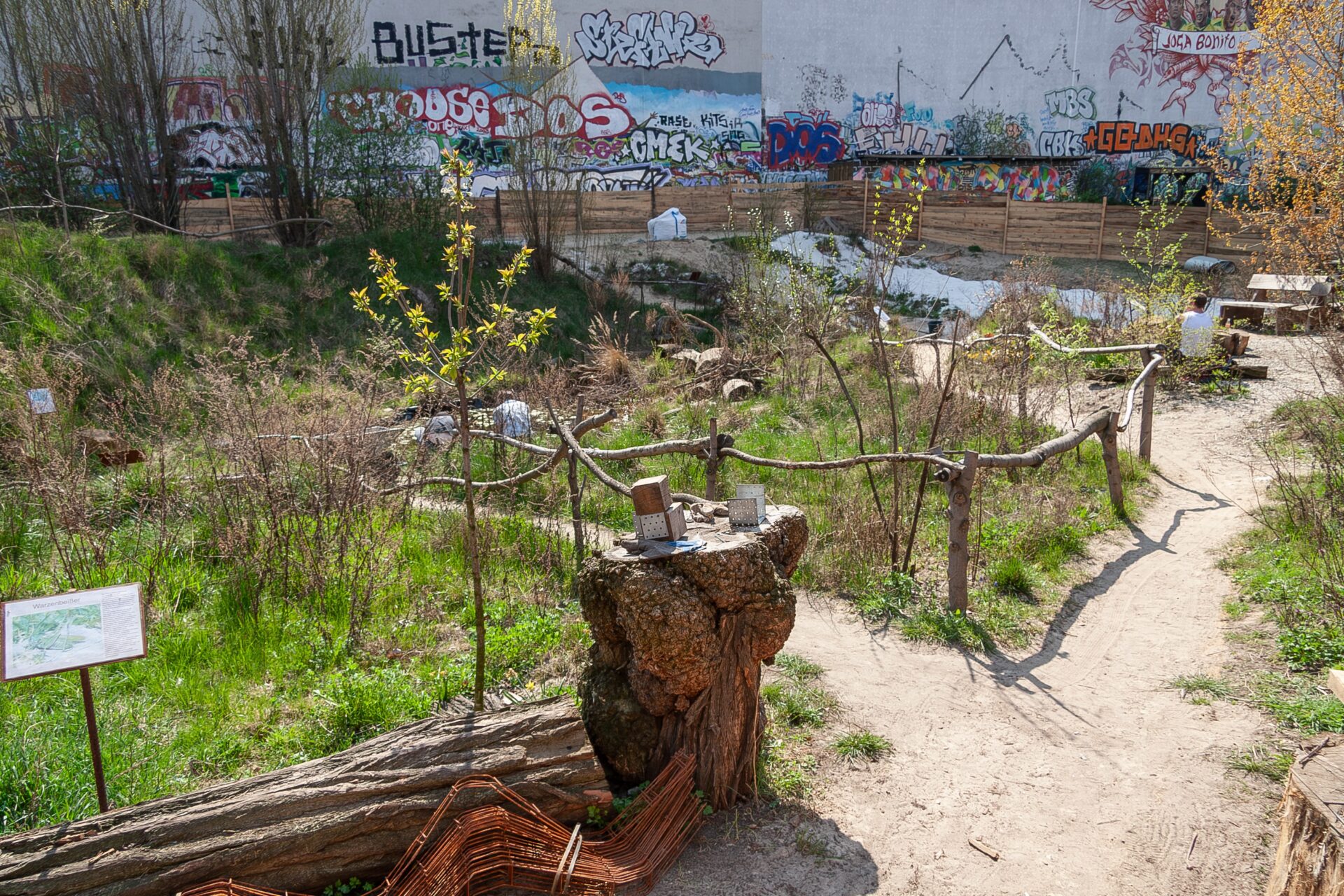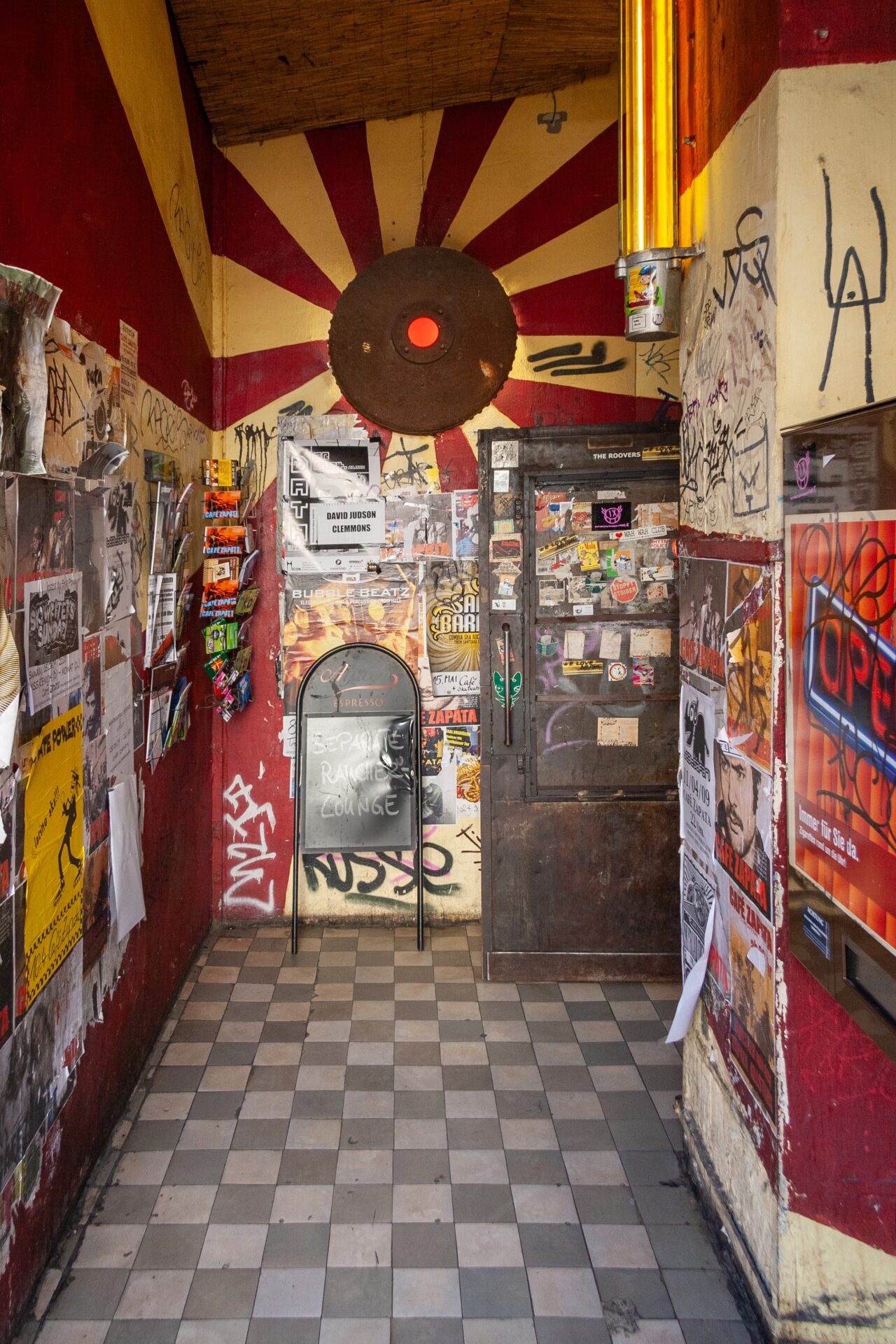In September 2023, Fotografiska opened a “Contemporary Museum of Photography, Art and Culture” inside the preserved building of the former Kunsthaus (art house) Tacheles. Tacheles was the name of an East German free jazz band whose members were among the 20-some artists who, in February 1990, occupied the ruins of a department store. It was once part of the colossal Friedrichstrassen-Passage in Berlin-Mitte, whose construction dates to the early 20th century. The band’s name, “Tacheles”, which is Yiddish for “straight-talking”, or speaking one’s mind bluntly without holding back, referred to its members’ musical style, and it served as a kind of unfixed score for radical cohabitation and art making that grew over the years. Giving the self-organized space the same name was also a clear statement against the history of the Friedrichstrassen-Passage as a Nazi Party office and prison located just across the street from the New Synagogue, which had survived the pogrom of 1938.
From 1990 until the artists’ eviction 22 years later, Tacheles rose to international fame as an idiosyncratic landmark of Berlin’s 90s and 00s cultural scene. Like many other projects of that time, Tacheles was characterized by practices of squatting and self-organization, but also a certain post-Wende idealism, that another world based on free expression and self-determination was possible. Yet this idealism was called into question when Tacheles was privatized by the Treuhand — an agency established by the German Democratic Republic to (re-)privatize state-owned assets — and purchased in 1998 by the Fundus-Gruppe, which signed a symbolic 10-year lease with the artists and later went bankrupt, leading its financier HSH Nordbank finally to evict and sell off the property in 2012. The building was acquired in 2014 by New York-based asset management and advisory firm Parella Weinberg.
Today, the former Tacheles building is part of an 85,000 m2 luxury mixed-use development named Am Tacheles, a verbal shift that nonsensically crystallizes the act of “straight-talking” into a fixed place (“at the straight talk”), flipping the original meaning of “Tacheles” on its head. What does this place, whose name alludes to its predecessors, have to do with straight-talking anymore? While the project’s starchitects Herzog & de Meuron have acknowledged the artists for saving the building from demolition, they wrote in 2016, two years after they were first commissioned for the project, that Tacheles “had deteriorated into a silent ruin with neither content nor context”, tacitly accepting gentrification as the inevitable root cause. In its press materials, pwr development, the sister company of Parella Weinberg that realized the development, claims that the unbuilt land surrounding the building laid “fallow” for decades, yet the fact that in 2012 bulldozers forcefully removed built and organic structures there contradicts this fallacy. What aspect of Tacheles were HdM referring to falling into ruin? Was it Tacheles, the building, which the artists, in fact, rehabilitated and maintained for decades without remuneration, or the social project with its post-Wende idealism?
In either case, today, the building has transitioned from a place of cohabitation and production to a place primarily of consumption. Contrasting starkly with the radical collective practices of Tacheles, the building’s new occupant, Fotografiska Berlin, a subsidiary of the Swedish-owned branded chain of upscale venues, operates transparently under a neoliberal logic and targets a relatively privileged audience compared to Tacheles’s former diverse group of producers, participants, and visitors. Fotografiska is thus a paradigmatic example, not of the open Berlin of the 90s or 00s, but of the exclusive city it is becoming. At the opening ceremony, Berlin Senator for Culture and Community Joe Chialo poignantly stated, “The new Fotografiska is an inspiring example of the connection between business and culture; of how creative visions and entrepreneurial spirit can go hand in hand.” But whom does this connection really serve?
In May 2009, mere months after Kunsthaus Tacheles lost its symbolic lease with the then property owner Fundus-Gruppe, I took these photos of the building. My relationship to Tacheles was mostly that of a spectator, going there to meet friends at the café or cinema. Yet, it also represented a space of radical freedom for me and the social milieu I inhabited, which cut across class. Like the independent art scene and, to an extent, the club scene, it was an example of Berlin’s literally free and publicly accessible spaces where, despite inherent contradictions, all levels of society could interact and come together for a common cause. This freedom and accessibility, which are key features of truly inclusive public spaces, are missing at Am Tacheles — and increasingly all over Berlin — today.
Two films recently shown at Babylon Berlin, Aufgestanden in Ruinen (1992) and Unverwüstlich (2012), document Tacheles’s first and final years, respectively. The films depict Tacheles coming into being against the backdrop of the Wende as a much-needed Freiraum, a free space where people could develop their own ideas independently. This was especially important for East Germans amid the Wende, the period of transition when East Germany became part of the Federal Republic of Germany (West Germany), having lived for decades under one-party communist rule. The first East German artists to squat the building successfully prevented it from being demolished for a planned roadway project. Neighbouring buildings had already been levelled, leaving behind an expansive wasteland. Unlike the top-down, state-managed spaces of East Germany, this free space would come to be self-managed by squatters and the neighborhood, eventually hosting metalworking areas, a sculpture park, and a biotope among other features.
Artists came to Tacheles from the East, the West, and around the world, attracted by the creative freedom it offered. Up to 60 artists lived there at a time, working in 30 artist studios. However, by the mid-90s, the post-Wende idealism of the original artists, which, according to Leo Kondeyne in Unverwüstlich, was a kind of communism and a negation of the capitalist demand to consume, was already being curbed by the inequalities newly produced under capitalism. While Easterners approached Tacheles as a reprieve from authority and a chance to build something new and beyond known state socialist institutions, Westerners, who had grown up under capitalism, came to the project with inherited institutional models and intentions fitting the new post-Wende regime, unable to meet Easterners on their own terms. While Westerners had a tremendous advantage — more than often they could rely on financial support from their families and already knew how to navigate the system — Eastern artists had to figure everything out anew: their lives, how to make a living, the political system. The reality of the new system hit them hard, making it difficult to continue with the project. Tacheles became more institutional, also in legal terms, which allowed it to exist semi-formally, but also created a feeling of alienation and came at the cost of autonomy.
Despite these and other conflicts, including disputes around the commercialization of the lower floors that was at odds with the squat’s original anti-capitalist ideals — particularly around the bar, which became a profitable enterprise that eventually broke with the organizational structure of the house — the Tacheles “score” set in motion by the band in 1990 kept on being interpreted by a changing cast of artists, shifting with and against the politico-economic landscape of gentrifying central Berlin. By the 00s, Tacheles had developed into an iconic cultural space symbolic of the post-Wende era, a collectively produced artwork filled with graffiti and interventions of all kinds by countless individuals over decades. This image contributed to it becoming a major tourist magnet, which artists used to their benefit by selling artworks to visitors to fulfill the practical demands of their collective dream. Yet, their income was poorly matched against neoliberal market demands.
In 2022, Berlin’s government came out with a budget surplus for the first time since the Wende. This was a milestone in Berlin’s transformation from a “poor but sexy” city into a capital where financial investments finally pay off. The once vibrant squatting scene has long been crushed, with the last few projects facing imminent eviction, as was the fate of the anarcha-feminist squat Liebig34 in October 2020, and most recently appeared to be the inevitable fate of the queer squat Tuntenhaus. Rather than protecting these self-organized domiciles and vital community centers, for example through public acquisition — as in the case of Tuntenhaus, where the District of Pankow was able to acquire the property with the intent of selling it to a non-profit foundation — the city at large, despite attempts to reverse the privatization of property, has favored privatizing land and assets with its attendant consequences: displacing residents from the central neighborhoods.
Alongside housing, the free art scene has also struggled to maintain spaces for production and exhibition. According to the professional association of visual artists bbk berlin e.V. with support from the Artists’ Social Insurance Fund (KSK), in 2023, the Berlin yearly average income for male artists was 18,256€ and for female artists 12,166€. These figures are based on artists’ self-assessment of their expected income for the year and represent their taxable income after deductions, and this information is subject to periodic reviews and audits to ensure accuracy. For comparison, the 2023 Berlin average income across all disciplines was 46,500€, and single parents with a child are considered at risk of poverty by the Berlin Senate if their income is below 18,504€. Although the city government has provided supplementary funding for a limited number of artist studios (since 1993) and project spaces (since 2016) in recognition of the struggle evidenced by these figures, artists are clearly the furthest from making a living in the city today. Berlin has an identity as a refuge for artists, but unless the city government increases its commitment to working artists, this reputation will remain under existential threat, contributing toward an environment of harsh competition and exclusion that favors artists from privileged backgrounds above all.
For the former Tacheles building, which exists under historic preservation, the urban development plan dating back to 2003 stipulates a cultural use, which can be interpreted in many ways and does not exclude commercial uses. Its current occupant, Fotografiska Berlin, is a private enterprise, which, despite calling itself a museum, is not a collecting institution. Out of the total 5,500 square meters the building encompasses, only 1,000 are used for exhibition, with the remaining four-fifths reserved for gastronomy. This distribution of programming reflects the tenant’s entrepreneurial use concept, which, alongside art presentation, includes curated retail, fine dining, cocktail bars, and private events. A ticket to enter the exhibition space costs between 14 and 16€, and visitors are invited to partake in other “elevated yet unpretentious” offerings while there. To accommodate cash-strapped local artists, the exhibition is free one day per month.
Undoubtedly, Fotografiska Berlin has high running costs, and in the absence of direct public funding, its business concept needs to provide sufficient income to balance expenses. Yet this burden, at least partially, is passed onto visitors. Publicly funded institutions with similar contents charge less for entry and offer more exhibition floor area. Independent project spaces across the city continue to offer platforms for artistic presentation and networking, almost always free of charge. Why even go to Fotografiska? According to pwr development, Tacheles should remain a place where local artists can get involved, which was at least reflected in its inaugural exhibitions featuring Berlin-based artists. Yet, it is hard to imagine that even a substantial minority of artists in the city has a place here, either out of a lack of funds or motivation.
Tacheles’s original slogan, “The ideals are ruined — save the ruins!” hits differently today. The artists of Tacheles may have succeeded in saving the ruins of the former department store, and while their ideals arguably still exist, their project has been ruined. A kind of violence was perpetrated against them that goes by many names, including gentrification. What remains of their efforts is the necrotic space of a forcefully disbanded and displaced community. Tacheles has seemingly been dipped in formaldehyde, all traces of communal life removed from its architecture, a frozen remnant encircled by a cathedral of capitalism. Am Tacheles is clinical and aseptic. An assemblage of shops, offices, and apartments for the ultra-rich have turned Tacheles into nothing but an anachronistic curiosity. Bowing to pressure from investors, Berlin’s urban planning has sacrificed the precious self-organized spaces that gave the city its international reputation, only for them to be replaced by exclusive commercial enterprises, of which Tacheles is a prime example.
Could a deeper analysis of Tacheles’ history bring new revelations? What conclusions could be drawn toward future action? When questioned after a film screening about how he felt when walking past Tacheles today, Klaus Tuschen, the late director of Aufgestanden in Ruinen, simply said, “I weep.” Looking at my photos, I am confronted once again by the question painted on Tacheles’s façade: “How long is now?” (which is now gone). It is precisely the loss of this “now” that makes the built substance of Tacheles feel like a corpse, every passing-by an invitation to mourning — not only the then of 90s Berlin, but also the lost future it represents. Perhaps it is time to save the ideals once again — the question is, where?
The author thanks Nils Gore for creating an impulse to take photos back in 2009 and Manuela Koelke for her thoughtful contribution toward the development of this text.
